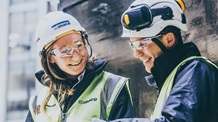Energy usage - the forgotten child of sustainable building
Within the built environment, we’ve become so accustomed to discussions about carbon reduction, that it has almost become synonymous for sustainable building. Whilst reducing carbon remains pivotal, contractors and businesses must also consider energy consumption as a cornerstone of their overall strategy. Reducing energy demand automatically saves carbon.
Mace has a moral imperative to save energy. As UK PLC moves away from direct fossil fuel consumption to a fully electric economy, we have a moral obligation to lower demand. We need to improve our energy productivity, to lower the burden on the wider UK energy infrastructure.
Improvements in energy productivity will also deliver a commercial reward.
The energy demand of a construction project is a huge part of the overall energy lifecycle, with buildings accounting for almost a third of the world’s energy usage. Businesses cannot be complacent in reducing that kind of consumption. As targets and commitments on energy usage become more integral to business decision-making, Andrew Mitchell, Sustainability Operations Director at Mace, looks toward the burgeoning technologies that will help us get there.
The right fuel is an invaluable tool
A driver of onsite energy consumption is the machinery that we use to complete work – quite literally! Everything from excavators and cranes, to vans and flatbeds are a piece of the energy and emissions puzzle. With most vehicles still reliant on liquid fuels and internal combustion, they are a major contributor to overall output of energy and GHG emissions. The clear long-term answer to this, as we are seeing with consumer vehicles, is a move to electrification.
It is encouraging to see smaller projects that have successfully electrified onsite equipment and vehicles, such as a near-zero emissions development in Oslo. However, we are still some way from deploying Electric Vehicles at scale on sites and it is important to make strides now, to support energy reduction targets. At Mace, we have completely removed diesel from our sites and made a shift towards HVO, a low-carbon fuel derived from reclaimed cooking oil. With solutions like these low-carbon fuels available now, the industry has a reliable stopgap, yet still with an eye to an EV future.
Offsetting with offsite
A more widely established practice for building is a growing appreciation of offsite manufacturing, with many components and fabrications able to be prepared in a controlled factory environment and delivered to the site itself. Well-founded benefits of this practice include efficiency of manufacture, worker safety and build quality - and we can add sustainability to that list. By building offsite there is a proven reduction of waste materials and the efficiency of manufacturing means that less energy is used to deliver the finished product. A great example of this is low carbon cassettes which are a modular concrete structure, capable of reducing embodied carbon in an office structure by up to 75%. By leaning in on offsite manufacturing, we can make sites safer, more efficient and more energy efficient.
Monitoring and optimising through digital solutions
Beyond the practical innovations that can improve energy usage, there is also a need to continue measuring and analysing our performance against current energy targets, to help inform future ones. Digital measurement and more sophisticated data will be the key to unlocking insights for contractors and their clients. Using Big Data – a full analytical process using the data your organisation collects – to give more granular information on energy levels will be instrumental in spotting problem areas and supporting companies to create tailored energy reduction strategies. With ESG reporting now integrated with overall financial reporting and commercial performance, adopting sophisticated analytics is fast becoming a must have.
Carbon emissions and energy consumption are not mutually exclusive - they are deeply intertwined and both huge priorities for the built environment. The fact that energy is slightly overlooked is already being remedied by new commitments across industries. Mace recently became the first major contractor to join the Climate Group’s EP100 ‘Double Energy Productivity’ pledge, which will see us use many of the innovations above to deliver the same level of work for 50% of the total energy demand between now and 2048. As we all continue the charge to build more sustainably, let’s put proactive steps to reduce on-site energy usage at the heart of it.
This article was originally published in Construction News.












